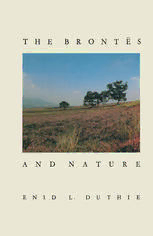
The Brontës and Nature PDF
Preview The Brontës and Nature
THE BRONTES AND NATURE Also by Enid L. Duthie L'INFLUENCE DU SYMBOLISME FRANQAIS DANS LE RENOUVEAU POETIQUE DE L'ALLEMAGNE PASSAGES FROM FRENCH LITERATURE FOR ANALYSIS AND COMPARISON THE FOREIGN VISION OF CHARLOTTE BRONTE THE THEMES OF ELIZABETH GASKELL THE BRONTES AND NATURE Enid L. Duthie Palgrave Macmillan ISBN 978-1-349-18375-3 ISBN 978-1-349-18373-9 (eBook) DOI 10.1007/978-1-349-18373-9 © Enid L. Duthie, 1986 Softeover reprint ofthe hardcover 1st edition 1986 978-0-333-39848-7 All rights reserved. For information, write: Seholarly & Reference Division, St. Martin's Press, Ine., 175 Flith Avenue, New York, NY 10010 First published in the United States of Ameriea in 1986 ISBN 978-0-312-10599-0 Library of Congress Cataloging-in-Publieation Data Duthie, Enid Lowry. The Brontes and nature. Bibliography: p. Includes index. 1. Bronte, Charlotte, 1816-1855-Critieism and interpretation. 2. Bronte, Emily, 1818-1848-Critieism and interpretation. 3. Bronte, Anne, 1820-1849- Criticism and interpretation. 4. Nature in literature. 5. Bronte family. 6. English literature -19th century History and critieism. I. Title. PR4169.D8 1986 823'.8'09 85-30352 ISBN 978-0-312-10599-0 To the Memory 01 Eleanore Waldock Contents Acknowledgements Vlll Introduction IX PART I NATURE AND BACKGROUND The Common Heritage 3 2 Nature in the J uvenilia 48 PART 11 ANNE BRONTE AND NATURE 3 Poems 73 4 Agnes Grey 90 5 The Tenant of Wildfell Hall 102 PART 111 CHARLOTTE BRONTE AND NATURE 6 Poems and The Professor 119 7 Jane Eyre 133 8 Shirley 157 9 Villette 175 PART IV EMILY BRONTE AND NATURE 10 Poems 197 11 Wuthering Heights 221 Conclusion 247 Notes 252 Selective Bibliography 265 Index 269 VII Acknowledgements The author and the publishers wish to thank the following who have kindly given permission for the use of copyright material: Macmillan, for extracts from Edward Chitham's The Poems 01 Anne Bront;!: a New Text and Commentary (1979); to the Folio Society, for extracts from Charlotte Bronte's Five Novelettes, edited by Winifred Gcrin (1971); and to Columbia University Press, for extracts from The Complete Poems of Emily Jane Bronti, edited by C. W. Hatfield (1941). Thanks are also due to John Murray for the use of the Haworth edition of the Bronte works and Mrs Gaskell's Lift of Charlotte Bronti!; to Hodder & Stoughton for extracts from The Complete Poems 01 Charlotte Bronte', edited by element Shorter; and to the Bronte Society for references to valuable material in their Transactions . I should also like to express my sincere gratitude to the staff of the University Library, Exeter; to the staff of Howard Print, Exeter, for their competence and courtesy in dealing with the typescript; and finally to Mr T. M. Farmiloe, and also to Miss Frances A. Arnold, of Macmillan, to whose help and unfailing consideration I am deeply indebted. Vlll Introduction Critical works on the Brontes are so numerous that it seems as if any fresh study must inevitably risk discussing questions already examined. The present study has, however, been undertaken in the belief that its subject has not yet received all the attention it merits. It has long been recognised that nature plays an import ant part in the works ofthe Bronte sisters. But its role has not yet been fully considered, nor has it been generally realised that their approach to nature offers one of the surest criteria for distinguishing the originality of each as artists, an originality necessarily connected with their individual temperament and outlook. They had inevitably much in common, for they shared the same Celtic ancestry, the same Pennine background, the same Parsonage upbringing. They were all avid readers, and authors from childhood onwards, and they grew up at a time when, with the triumph ofRomanticism, the concept ofnature had gained a new significance, a significance embracing the whole of human life. The Romantic concept ofnature was essentially poetic, and all the Brontes were poets, though Emily alone attained greatness in the medium of verse. But they also brought the Romantic approach to nature, at once metaphysical and profoundly human, into the novel, an achievement the more memorable because it took place in an era of growing industrialisation. Each did so, however, in their own way, Anne modestly, but not ineffectively, Charlotte with most variety, Emily with most ele mental force. English literature, which owes so much to the Romantic vision of nature, is the richer today for the distinctive contribution of each. IX Part I Nature and Background
